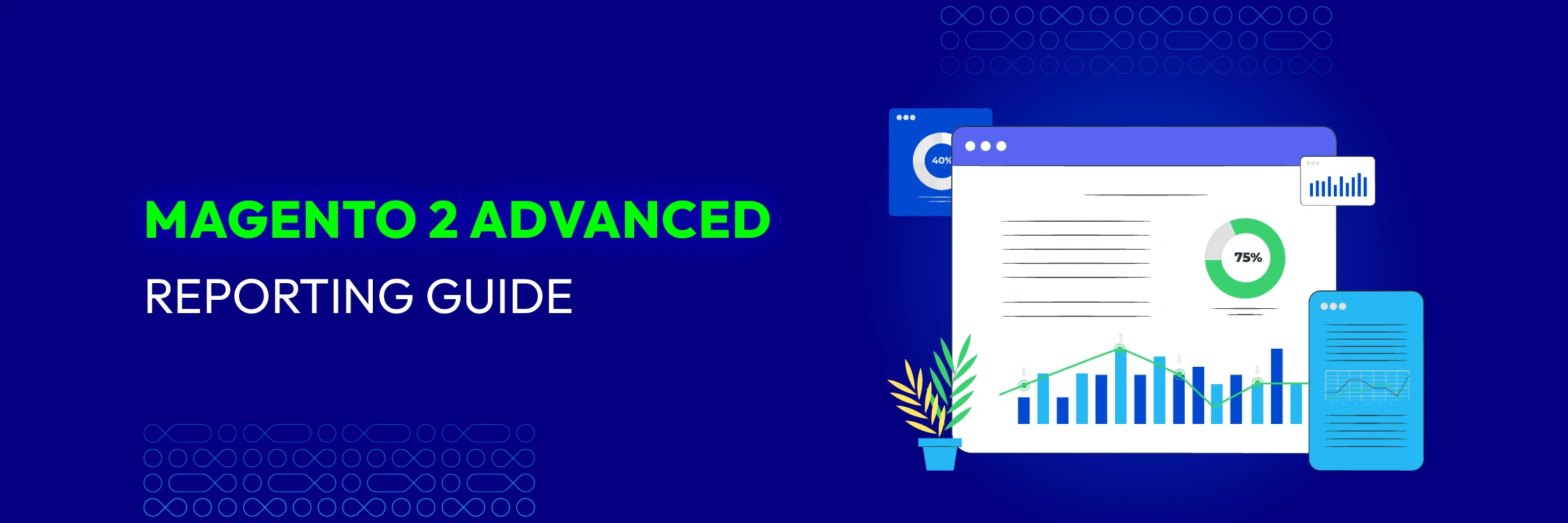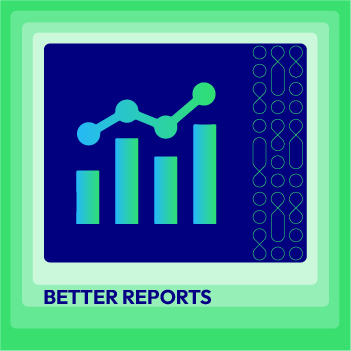Magento 2 Advanced Reporting Guide (2025 updated)
Vinh Jacker | 07-01-2021

Running an eCommerce business these days comes with several challenges in enticing customers. Convincing customers to make purchases is just the iceberg’s tip.
When the e-commerce competition has become intense day by day, it takes an e-retailer to go the extra mile to stand out from the pack. People have started talking and considering differentiation and personalization more.
That’s why it’s understandable that a popular eCommerce platform like Magento attracts more clients with business intelligence. An analytics system enables enterprises to harness the power of data for better business decisions.
Still, in this post’s scope, we will talk about one of Magento Business Intelligence’s widely-used tools - Advanced Reporting.
What is Magento 2 Advanced Reporting?
Advanced Reporting is provided as a part of both Adobe Commerce and Magento Open Source. This functionality offers the ability to utilize a range of dynamic reports generated from your product, order, and customer data. The personalized dashboard offered by Advanced Reporting is specifically customized to suit your unique business requirements. Despite Advanced Reporting utilizing Business Intelligence for its analytics capabilities, it is important to note that owning a Business Intelligence account is not a prerequisite for utilizing Advanced Reporting.
Magento 2 Advanced Reporting Requirements
As mentioned above, Magento 2 Advanced Reporting comes with no charge to use. And it’s available for only Magento installation (quite obviously).
Still, there are some prerequisites you should be aware of in order to use Advanced Reporting for your Magento stores, particularly:
-
The need to run on a public web service
-
Make sure your Magento store has been installed or upgraded with no error
-
Most importantly, Advanced Reporting is available only to the Magento installations that have used a single base currency since the installation time. If you have orders processed with different base currencies, it won’t work
-
In the Magento configuration, your settings for the Base URL are correct. This means that the store view needs to be able to point to the secure URL. Plus, remember to set Use Secure URLs on the storefront and Use Secure URLs in Admin = Yes
-
The Magneto crontab is created successfully at the store’s backend, and there’s nothing wrong with cron jobs on the installed server
Note: It can take you a day for Advanced Reporting to collect and analyze data.
One recommended solution is to set a preferable time of day for data collection. This action can help you avoid system overload during its prime time.
How to use Magento 2 Advanced Reporting?
Step 1: Activate the Advanced Reporting from the store’s backend
-
Go to your Magento store’s backend, then navigate to
Stores > Settings > Configuration -
Expand the General section and tap on the Advanced Reporting
In this area, you need to configure some settings for the Magento Advanced Reporting, including:

-
Set Advanced Reporting Service = Enable (Default setting)
-
Time of day to send data: Here, you can set the specific time (hour/ minute/ second) for when Advanced Reporting will receive your store’s updated data. By default, this field is set up at 2:00 Am
-
Industry Data: Select your industry in the drop-down list so that the analytics of Advanced Reporting can be more personalized
-
Finally, click on the Save Config button when you’re done
Don’t forget to check your subscription’s status and ensure that your installation meets all the conditions.
Step 2: Access Advanced Reporting from the Admin Panel
Now, you have completed the step that allows Magento Advanced Reporting to collect and analyze your store’s data. It’s time to see the results.
To see the Magento 2 Advanced Reporting dashboard, go to Reports > Business Intelligence > Advanced Reporting. The dashboard of Advanced Reporting comes with 3 primary tabs:
-
Orders: Offer 12 different types of reports, from Revenue, AOV to Tax and Shipping fees
-
Customers: Coms with 4 reports on Unique Customers, New Registered Accounts, Top Coupon Users, and Customer KPI Table
-
Products: Display 4 product reports including Quantity of Product Sold, Products Added to Wishlists, Best Selling Products by Quantity and Revenue

You just need to click on the wanted tab and scroll down to see its full report. Magento provides its users with the Filters feature placed in the upper-right corner to better view the data. It allows you to set the wanted period and even the store view to include in the report.
Access Data resources from the Advanced Reporting dashboard

While viewing all dashboard reports from the store’s backend, Magento enables users to get quick access to the Magento Data Resources. This is where you can get helpful information through 3 main sections:
-
Thought Leadership
-
Support
-
Magento Business Intelligence
To access Data Resources, just click on the Additional Resources in the upper-right corner of the Advanced Reporting dashboard.
Top 5 Magento 2 Report Extensions to Boost your Business Growth
1. Mageplaza Advanced Reports extension
Mageplaza’s Advanced Reports extension enhances Magento 2’s default reporting capabilities by providing a comprehensive suite of customizable reports. It enables store owners to track and analyze various business metrics, facilitating data-driven decisions.
Key features:
- Customizable report periods: Define specific time frames for data collection and comparison to monitor performance over desired periods.
- Advanced reports: Access additional reports such as Sales by Location, Conversion Funnel, and Repeat Customer Rate, offering deeper insights into customer behavior and sales trends.
- Visual data representation: Utilize line charts and graphs for a clear visualization of statistics, making complex data more accessible.
- Flexible dashboard layouts: Customize the admin dashboard by rearranging and resizing report cards to prioritize essential metrics.
- Multiple report dashboards: Manage and switch between different dashboards tailored to various analytical needs.
Pricing:
- Standard edition: $99
- Professional edition: $199
- Ultimate edition: $299
2. Mirasvit Advanced Reports extension
This plugin is a flexible and user-friendly analytics tool designed to enhance Magento 2’s default reporting. It offers a variety of ready-to-use reports and the ability to create custom ones, enabling comprehensive data analysis.
Key features:
- 20+ ready-to-use reports: Access a wide range of pre-built reports covering sales, products, customers, and more.
- Custom report builder: Create personalized reports and columns to focus on metrics that matter most to your business.
- Custom dashboards: Build dashboards that display key performance indicators (KPIs) relevant to your objectives.
- Mobile dashboard access: Monitor your store’s performance from any device, ensuring you stay informed on the go.
- Google sheets integration: Seamlessly export and share reports with stakeholders using Google Sheets.
Pricing:
- Community edition: $219
- Enterprise edition: $499
- Magento Cloud edition: $789
3. Amasty Advanced Reports extension
Advanced Reports extension by Amasty provides Magento 2 store owners with a robust set of tools to analyze sales trends and make data-driven decisions. It offers a variety of ready-made reports and the flexibility to create custom ones tailored to specific business needs.
Key features:
- 20+ ready-made reports: Gain insights into various aspects of your store’s performance with a diverse set of reports.
- Dynamic dashboard: Keep essential metrics at your fingertips with a customizable and informative dashboard.
- Custom report builder: Design unlimited custom reports using pre-built templates and a user-friendly interface.
- Interactive charts: Visualize sales statistics with interactive charts for better data interpretation.
- Multi-currency support: Analyze sales data across different currencies, accommodating a global customer base.
Pricing:
- Advanced Reports: $259
- Advanced Reports Pro: $459
- Advanced Reports Premium: $529
4. Aheadworks Advanced Reports extension
Advanced Reports extension for Magento 2 by Aheadworks is designed to provide store owners with detailed insights into their business performance. It offers a variety of reports and dashboard widgets to monitor key metrics effectively.
Key features:
- Comprehensive dashboard: Access key metrics quickly through configurable dashboard widgets.
- Detailed sales reports: Analyze sales data by various parameters, including product performance and customer behavior.
- Abandoned cart analysis: Monitor and analyze abandoned carts to improve conversion rates.
- Scheduled email reports: Automate the distribution of reports to keep your team informed.
- Integration capabilities: Seamlessly integrate with other Aheadworks extensions for enhanced functionality.
Pricing:
- Annual subscription: Starting at $382
- One-time 5-year license: Pricing available upon request
5. BSS Commerce Inventory Report extension
The BSS Commerce module for Magento 2 focuses on providing detailed insights into inventory levels and movements. It helps store owners manage stock effectively and make informed purchasing decisions.
Key Features:
- Real-time stock tracking: Monitor current stock levels to prevent overstocking or stockouts.
- Predictive analytics: Utilize sales data to forecast future inventory needs accurately.
- Stock movement history: Keep a detailed record of stock changes for auditing and analysis.
- Low stock alerts: Receive notifications when stock levels fall
Pricing:
- CE: Starting at $99
- EE/Cloud: $198
The bottom line!
You’ve probably heard this before, but it’s worth repeating—personalization and data-driven strategies are key to business success. In the digital world, where competition is fierce, reports and analytics are more critical than ever.
Tracking your business performance over time allows for continuous optimization, helping you stay ahead of the market. Investing in a powerful Magento 2 Reports extension gives you the insights needed to make informed decisions and drive success both online and offline. Don’t miss the opportunity to harness the power of data to scale your business effectively!
Related posts:










